Death Valley off-road motorcycle adventure
December 26-30, 2014
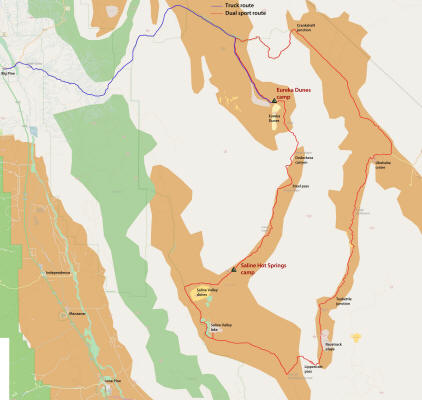 Death
Valley is a great location for rides with a dual sport or adventure capable motorcycle. Some of
the roads tend to be fairly rough and only passable otherwise via a high
clearance 4wd. At the same time, the distances tend to fairly long, so
having a bike with some range and stamina can also be beneficial. I have been interested in some overnight rides on some of
these roads since picking up a new 2013 Suzuki DRZ400S about a year ago,
after being a long time rider on full size street bikes the last 30 years
(currently also have a 1993 Honda ST1100). Although the DRZ400 is on
the smaller side for adventure riding, it is quite capable with good agility
and nimbleness. Near the end of December 2014
myself and another motorcycle riding friend Randy (who also has a 2009
DRZ400S) packed our bikes in the back of his old Chevy 3/4 ton diesel work truck, and hit the road to Death Valley for a five day trip. I
have to say that after watching the multi-part series on "Long
Way Round" concerning two riders (Ewan McGregor and his sidekick Charley Boorman) traveling 20,000 miles on their bikes mostly around the
world, it has given me the adventure riding bug. So one
purpose of this trip was put the bikes and ourselves through a short
adventure shakedown and see how things do for more and longer rides in the
future.
Death
Valley is a great location for rides with a dual sport or adventure capable motorcycle. Some of
the roads tend to be fairly rough and only passable otherwise via a high
clearance 4wd. At the same time, the distances tend to fairly long, so
having a bike with some range and stamina can also be beneficial. I have been interested in some overnight rides on some of
these roads since picking up a new 2013 Suzuki DRZ400S about a year ago,
after being a long time rider on full size street bikes the last 30 years
(currently also have a 1993 Honda ST1100). Although the DRZ400 is on
the smaller side for adventure riding, it is quite capable with good agility
and nimbleness. Near the end of December 2014
myself and another motorcycle riding friend Randy (who also has a 2009
DRZ400S) packed our bikes in the back of his old Chevy 3/4 ton diesel work truck, and hit the road to Death Valley for a five day trip. I
have to say that after watching the multi-part series on "Long
Way Round" concerning two riders (Ewan McGregor and his sidekick Charley Boorman) traveling 20,000 miles on their bikes mostly around the
world, it has given me the adventure riding bug. So one
purpose of this trip was put the bikes and ourselves through a short
adventure shakedown and see how things do for more and longer rides in the
future.
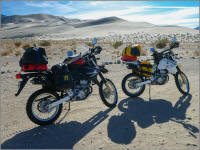 The plan was to spend two of the days on an overnight motorcycle ride via a
150 mile loop through fairly rough terrain starting and ending at the Eureka Dunes.
The route has us starting up through Deckedera Canyon passing just to the
east of the Eureka Dunes, over Steel Pass and down to the Saline Valley hot
springs for the overnight camp. On the second day, we then planned on
heading down to the bottom of Saline Valley, then head south to the
Lippencott mine road, taking this over the pass and down to the Racetrack.
From the Racetrack playa, then head northeast to Ubehebe crater. From the
crater, the plan was then to return back to the Eureka Dunes camp where the
truck was parked by heading north on Death Valley road, passing Crankshaft
junction along the way. The map to the right illustrates the
route, and if clicked on expands to a much more readable size.
The plan was to spend two of the days on an overnight motorcycle ride via a
150 mile loop through fairly rough terrain starting and ending at the Eureka Dunes.
The route has us starting up through Deckedera Canyon passing just to the
east of the Eureka Dunes, over Steel Pass and down to the Saline Valley hot
springs for the overnight camp. On the second day, we then planned on
heading down to the bottom of Saline Valley, then head south to the
Lippencott mine road, taking this over the pass and down to the Racetrack.
From the Racetrack playa, then head northeast to Ubehebe crater. From the
crater, the plan was then to return back to the Eureka Dunes camp where the
truck was parked by heading north on Death Valley road, passing Crankshaft
junction along the way. The map to the right illustrates the
route, and if clicked on expands to a much more readable size.
Given the lack of any services other than outhouse at the two camping
locations, we equipped the bikes to carry all our
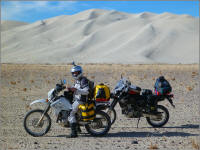 camping gear, food, water,
fuel, tools and extra tire tubes. This was accomplished with a 1.75 gallon
Rotopax gas tank on the rear rack, a tank bag, two Wolfman saddle packs, and
another bag strapped to the top of the rear Rotopax tank, plus a 6 liter MSR
water bladder in one of the saddle bags for each bike. This probably added another 75 lb.
load to these 325 lb. bikes. I was curious how the bikes would perform with
this configuration, and figured this would be a good trip to see how well
the DRZ400S would do under these circumstances. Currently both of our bikes
are stock with respect to carb jetting, air-box mods, and exhaust; but both
have descent knobby tires, with myself using Michelin T63 dual sport tires
with about a thousand miles on them. The bikes are both sufficiently
armored with after-market radiator guards, case guards, a skid plate, and
bar guards. The rear saddle bag racks also tend to protect the rear of the
bike and exhaust against side damage during a fall, as I have learned from
previous rides.
camping gear, food, water,
fuel, tools and extra tire tubes. This was accomplished with a 1.75 gallon
Rotopax gas tank on the rear rack, a tank bag, two Wolfman saddle packs, and
another bag strapped to the top of the rear Rotopax tank, plus a 6 liter MSR
water bladder in one of the saddle bags for each bike. This probably added another 75 lb.
load to these 325 lb. bikes. I was curious how the bikes would perform with
this configuration, and figured this would be a good trip to see how well
the DRZ400S would do under these circumstances. Currently both of our bikes
are stock with respect to carb jetting, air-box mods, and exhaust; but both
have descent knobby tires, with myself using Michelin T63 dual sport tires
with about a thousand miles on them. The bikes are both sufficiently
armored with after-market radiator guards, case guards, a skid plate, and
bar guards. The rear saddle bag racks also tend to protect the rear of the
bike and exhaust against side damage during a fall, as I have learned from
previous rides.
After moteling it the first night in Bishop after an all day drive from Sacramento via Tahoe and down 395 from Gardnerville, we parked the truck at Eureka Dunes on the morning of the second day. After unloading the bikes and packing our gear, eating a quick lunch, by noon we headed out for the nights destination at the Saline Valley hot springs.
To document the trip we both had GoPro cameras, with mine on my handlebars via a Ram mount and Randy's on his helmet. I also carried a Panasonic TS-4 shock/waterproof point-and-shoot in by jacket, and Canon 70D DSLR with an 18-135mm EF-S STM lens in a padded case in my tank bag. We wanted to stop along the way and also capture some video sequences during segments of this ride, along with some from the bike via the GoPros.
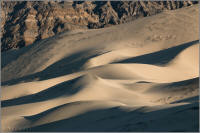 The first challenge encountered from Eureka Dunes is a couple of miles of
fairly deep sand on the road paralleling the left side of these dunes. This
did not present too much difficulty for us when we would keep the gas and
speed on the bike, staying in second gear, and trying not to make any
deliberate turns with the front wheel. It seemed better to weight the pegs,
standing more of the time, and just try to go with the ruts in the sand,
leaning the bike more in order to steer. Perhaps having more weight toward
the rear of the bikes with our big load also helped?
The first challenge encountered from Eureka Dunes is a couple of miles of
fairly deep sand on the road paralleling the left side of these dunes. This
did not present too much difficulty for us when we would keep the gas and
speed on the bike, staying in second gear, and trying not to make any
deliberate turns with the front wheel. It seemed better to weight the pegs,
standing more of the time, and just try to go with the ruts in the sand,
leaning the bike more in order to steer. Perhaps having more weight toward
the rear of the bikes with our big load also helped?
The next obstacle was about three different rocky and narrow ledges through
Dedeckera Canyon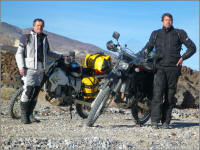 that have been a more notorious obstacle for 4wd vehicles. Randy went first, but apparently without enough speed, and ended up stalling
out in the rock garden in the middle of the first ledge. He was able get
over it by gassing the bike and steering out of it more toward the right and
then up. I tried next, and being concerned about the amount of boulders and
navigating the narrow path without being thrown, I also lacked enough speed
and stalled out in the middle. After rocking back a bit, goosing the
throttle, and spinning the rear tire I was able to keep going on a straight
path up and over. I think we were both a little thrown off by the
underperformance of the bikes with this extra load on this first substantial
climb, and perhaps with the
altitude peaking at about 5000 feet playing a role. After that experience of
the first ledge, the next ledges went easier with the application of more
speed, letting the momentum of the bikes weight carry us over, and perhaps
with a bit more confidence.
that have been a more notorious obstacle for 4wd vehicles. Randy went first, but apparently without enough speed, and ended up stalling
out in the rock garden in the middle of the first ledge. He was able get
over it by gassing the bike and steering out of it more toward the right and
then up. I tried next, and being concerned about the amount of boulders and
navigating the narrow path without being thrown, I also lacked enough speed
and stalled out in the middle. After rocking back a bit, goosing the
throttle, and spinning the rear tire I was able to keep going on a straight
path up and over. I think we were both a little thrown off by the
underperformance of the bikes with this extra load on this first substantial
climb, and perhaps with the
altitude peaking at about 5000 feet playing a role. After that experience of
the first ledge, the next ledges went easier with the application of more
speed, letting the momentum of the bikes weight carry us over, and perhaps
with a bit more confidence.
After the ledges of Dedeckera Canyon (which is more of a pass), the riding was fairly easy and fun along the way up to the top of Steel Pass. The descent from Steel Pass toward Saline Valley is fairly steep at first with a couple of big rock garden ledges in the middle. Since we were going downhill, this was relatively easy. But in discussing this later, we both felt it would be definitely more challenging going up this with the load that we were carrying. The conclusion is that perhaps for such rides in the future, more power would be helpful, and that it is probably time to do the carburetor re-jetting, air box modifications, and exhaust upgrade.
From the west side of Steel Pass all the way to the hot springs, the trail follows a wash on what you could characterize as an alluvial fan. The rock toward the top is more firm, allowing for a fairly fast pace. But soon the trail becomes much more loose and quite difficult, comprised mainly of deep gravel. The ride for the last 15 miles were more of a nail biter trying to keep the bikes balanced and heading in the right direction, maintaining a speed between 10 and 30 mph. We both completed this intact without crashing, but also each had a few close calls.
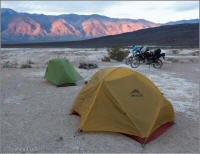 After reaching the lower hot springs (the main ones),
I identified a flat
area of ground above the springs to setup camp within walking distance, and
shortly after joined others in this clothing-optional hot springs for a much
needed clean-up and soaking. By then, Randy was already in the water
getting to know the other free spirits crazy enough to also come out here
either via the south or north pass roads.
After reaching the lower hot springs (the main ones),
I identified a flat
area of ground above the springs to setup camp within walking distance, and
shortly after joined others in this clothing-optional hot springs for a much
needed clean-up and soaking. By then, Randy was already in the water
getting to know the other free spirits crazy enough to also come out here
either via the south or north pass roads.
 There was also another group of 3 Israeli
motorcyclists from LA soaking in these hot springs. They came up for the day
from Panamint Valley via the south pass road up Saline Valley. They
had KTMs, ranging from a 990 Adventure to a 690 dual sport, and apparently
had blasted up this road bragging about hitting speeds up to 100 mph in the
flat sections. They headed out by around 4 pm, with the sun almost
ready to drop below the Inyo Mountains. I expressed concerned about
riding the rougher section of this road over south pass in the dark (having
done it a couple of years back in a 4wd), but they seemed nonplussed and
tore out of there, muttering about hoping not to run out of gas. One
them also had a Rotopax on the back that I figured they may end up having to
share.
There was also another group of 3 Israeli
motorcyclists from LA soaking in these hot springs. They came up for the day
from Panamint Valley via the south pass road up Saline Valley. They
had KTMs, ranging from a 990 Adventure to a 690 dual sport, and apparently
had blasted up this road bragging about hitting speeds up to 100 mph in the
flat sections. They headed out by around 4 pm, with the sun almost
ready to drop below the Inyo Mountains. I expressed concerned about
riding the rougher section of this road over south pass in the dark (having
done it a couple of years back in a 4wd), but they seemed nonplussed and
tore out of there, muttering about hoping not to run out of gas. One
them also had a Rotopax on the back that I figured they may end up having to
share.
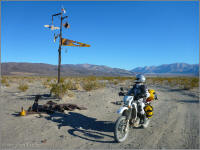 After breakfast and breaking camp
early the next morning, we headed out down to
Saline Valley being on the road by 9am.
After breakfast and breaking camp
early the next morning, we headed out down to
Saline Valley being on the road by 9am.
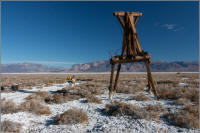 From there we then heading south to
the junction with Lippencott Mine road. Along the way stopping at the
dunes, lake, and old trestles from the salt tram that runs to the top of the
Inyo mountain range that used to be active here about 80 years ago. This
road was fairly easy with some loose sand in a few areas, but nothing that
difficult. Heading up over Lippencott pass, the road gets rockier, steeper,
and a bit more narrow. We had both expected this to be more challenging, but
none of this presented that much difficulty for the DRZs even with the extra
load. The ground for the road on Lippencott pass was fairly firm. In
general wherever the road is more compacted and used by other 4wd vehicles,
the easier it was for the bikes.
From there we then heading south to
the junction with Lippencott Mine road. Along the way stopping at the
dunes, lake, and old trestles from the salt tram that runs to the top of the
Inyo mountain range that used to be active here about 80 years ago. This
road was fairly easy with some loose sand in a few areas, but nothing that
difficult. Heading up over Lippencott pass, the road gets rockier, steeper,
and a bit more narrow. We had both expected this to be more challenging, but
none of this presented that much difficulty for the DRZs even with the extra
load. The ground for the road on Lippencott pass was fairly firm. In
general wherever the road is more compacted and used by other 4wd vehicles,
the easier it was for the bikes.
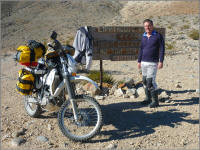 After eating lunch at the Grandstand parking area next to the Racetrack
playa, we debated whether fill up our bike tanks from the Rotopax tanks now
or wait. I argued it would be simpler to just run the bikes out of gas from
the main tank until we have to switch to reserve, and then pull over and
transfer fuel from the Rotopax tanks then. This would save us from having
to repeat this exercise again later. Sure enough, about 10 miles later and
within about a mile of each other we both ran out of gas from our main
tanks. At this point we had gone about 85 miles with the 1.9 gallon main
tank, which is about 10-15 miles less range then I have gotten when riding
more casually around my house and some back road dirt routes. It was also
quite interesting to see how consistent our DRZs were between us, given mine
is a 2013 and Randy's is a 2009. Other than the color of the bike, not much
else looks or feels different.
After eating lunch at the Grandstand parking area next to the Racetrack
playa, we debated whether fill up our bike tanks from the Rotopax tanks now
or wait. I argued it would be simpler to just run the bikes out of gas from
the main tank until we have to switch to reserve, and then pull over and
transfer fuel from the Rotopax tanks then. This would save us from having
to repeat this exercise again later. Sure enough, about 10 miles later and
within about a mile of each other we both ran out of gas from our main
tanks. At this point we had gone about 85 miles with the 1.9 gallon main
tank, which is about 10-15 miles less range then I have gotten when riding
more casually around my house and some back road dirt routes. It was also
quite interesting to see how consistent our DRZs were between us, given mine
is a 2013 and Randy's is a 2009. Other than the color of the bike, not much
else looks or feels different.
One additional comment on the use of the Rotopax tanks: The CARB (California Air Resources Board) compliant nozzle of our tanks ended up being a liability. It took me about 5 minutes to figure out how to get the fuel to flow, after only spilling gasoline over my hands. When I was finally done and not seeing Randy who was previously behind me, I figured he may have been running into similar difficulties. Doubling back 1~2 miles I found him on the side of the road with another off-roader who was helping him out. Apparently he was unable to get his CARB nozzle to work too, and ended up getting help from someone else who loaned him a regular out-of-state nozzle that also fit his tank in order to put gas in his bike. Looking at this nozzle later, I could not get it to work no matter how hard I tried, covering my hands in gasoline again in the process. The logic of this design defies me, as if the goal is to reduce emissions, it seems to only make matters worse due to the delicate and over complex operation that results in more spilled gasoline. They seem to introduce an extra health hazard in forcing the user to come in more direct contact with the gasoline in order to operate it via the twist and push design that requires a considerable effort. I think that the state bureaucrats that come up with these mandates or designs need to actually try to practice what they are trying to force on the rest of the population.
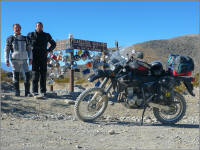 The next stop after the Rotopax CARB debacle was Ubehebe Crater. The bikes
did well on the extreme washboard of the road from the Racetrack. At some
straighter points I had the bike flying over this at 60 mph. After reaching
the crater parking viewpoint, I noticed my first casualty. Apparently the
plastic mount of my GoPro camera sheared in half off the handlebar. At this
point I had no idea where I might have lost it between there and Tea Kettle
junction (where it was last intact), and it seemed hopeless in doubling back
and trying to find it anywhere in the last 20 miles. Also, being
concerned that perhaps we not have enough
gas to do this and still make it back to our camp at Eureka Dunes where the truck is
parked, the only reasonable thing we could do was move on and file a
lost-and-found claim with the DV visitor center later. So if any of you readers
find a GoPro Hero 3+ silver edition in the waterproof plastic case on this
road, I would appreciate getting it back and the 32GB microSD card with
video footage from the ride on it too.
The next stop after the Rotopax CARB debacle was Ubehebe Crater. The bikes
did well on the extreme washboard of the road from the Racetrack. At some
straighter points I had the bike flying over this at 60 mph. After reaching
the crater parking viewpoint, I noticed my first casualty. Apparently the
plastic mount of my GoPro camera sheared in half off the handlebar. At this
point I had no idea where I might have lost it between there and Tea Kettle
junction (where it was last intact), and it seemed hopeless in doubling back
and trying to find it anywhere in the last 20 miles. Also, being
concerned that perhaps we not have enough
gas to do this and still make it back to our camp at Eureka Dunes where the truck is
parked, the only reasonable thing we could do was move on and file a
lost-and-found claim with the DV visitor center later. So if any of you readers
find a GoPro Hero 3+ silver edition in the waterproof plastic case on this
road, I would appreciate getting it back and the 32GB microSD card with
video footage from the ride on it too.

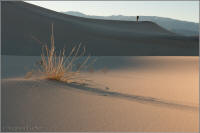 From Ubehebe crater we then headed north on Death Valley road to Crankshaft
junction and then back to Eureka Dunes. This road is all gravel and
washboard, but not as harsh as the road to the Racetrack. We were able to
cover it at a pretty good clip, reaching 60 mph in places, but in some
sections getting a bit of a surprise due to some small washouts in the
road. Nothing that popping the front wheel up at speed could not address.
Getting back to the truck by 3 pm, after a bit of a break, I still had time
for a little photography of the dunes at sunset. You can see some of
my other photography work of the Death Valley area, based on past visits in
my gallery
here.
From Ubehebe crater we then headed north on Death Valley road to Crankshaft
junction and then back to Eureka Dunes. This road is all gravel and
washboard, but not as harsh as the road to the Racetrack. We were able to
cover it at a pretty good clip, reaching 60 mph in places, but in some
sections getting a bit of a surprise due to some small washouts in the
road. Nothing that popping the front wheel up at speed could not address.
Getting back to the truck by 3 pm, after a bit of a break, I still had time
for a little photography of the dunes at sunset. You can see some of
my other photography work of the Death Valley area, based on past visits in
my gallery
here.

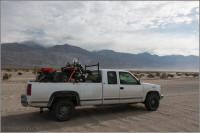 It was darn cold the second night at Eureka Dunes, dropping to about 16
degrees F according to a neighbor camper. All our water was frozen solid
(including the big 6 gallon tanks), putting some limitations on breakfast.
Randy's diesel truck wouldn't start when trying to leave due to the cold, so
we had to put the camp stove underneath the engine oil pan to warm it up,
running it for about 15 minutes with the engine hood closed. With all the grease and rubber hoses
underneath on a truck with 382,000 miles on it, I cringed that we would set the truck on fire
despite the high ground clearance. In the
end it worked and the truck started. Although Randy and another friend
Cliff have reminded me that diesel fuel has a higher flash point than
gasoline, In the future, I think I will load my
bike, camera gear, and other stuff into the truck after making sure it starts :^)
It was darn cold the second night at Eureka Dunes, dropping to about 16
degrees F according to a neighbor camper. All our water was frozen solid
(including the big 6 gallon tanks), putting some limitations on breakfast.
Randy's diesel truck wouldn't start when trying to leave due to the cold, so
we had to put the camp stove underneath the engine oil pan to warm it up,
running it for about 15 minutes with the engine hood closed. With all the grease and rubber hoses
underneath on a truck with 382,000 miles on it, I cringed that we would set the truck on fire
despite the high ground clearance. In the
end it worked and the truck started. Although Randy and another friend
Cliff have reminded me that diesel fuel has a higher flash point than
gasoline, In the future, I think I will load my
bike, camera gear, and other stuff into the truck after making sure it starts :^)
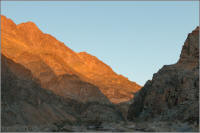
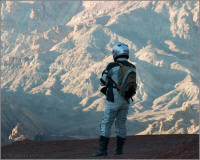 On the third day in the valley we did another
90 mile loop from Furnace
Creek up through Titus Canyon and back. That was also quite fun on the
motorcycles. But we got a late start (~2:30 pm) after the long drive from
Eureka Dunes that morning, grabbing a camp site, unloading the bikes from
the truck again, and wolfing down a quick lunch. As a result we had to blast through this entire
route in 3 hours, passing many vehicles on the way, returning just after
sunset around 5:30pm. Without the saddlebags loaded and no top bag on
the rear rack,
the bikes just ate up the route, feeling more lively without as much load. Ideally I would have liked to have spent more time on
this ride for photography, but was not keen about riding this rocky canyon
in the dark. Camping at Furnace Creek was crowded and noisy due to the holiday break,
getting one of the last camp sites near a boy scout troop group site.
On the third day in the valley we did another
90 mile loop from Furnace
Creek up through Titus Canyon and back. That was also quite fun on the
motorcycles. But we got a late start (~2:30 pm) after the long drive from
Eureka Dunes that morning, grabbing a camp site, unloading the bikes from
the truck again, and wolfing down a quick lunch. As a result we had to blast through this entire
route in 3 hours, passing many vehicles on the way, returning just after
sunset around 5:30pm. Without the saddlebags loaded and no top bag on
the rear rack,
the bikes just ate up the route, feeling more lively without as much load. Ideally I would have liked to have spent more time on
this ride for photography, but was not keen about riding this rocky canyon
in the dark. Camping at Furnace Creek was crowded and noisy due to the holiday break,
getting one of the last camp sites near a boy scout troop group site.
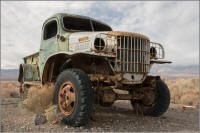 The more I camp off the beaten path
away from these congested camp grounds, the more I realize why I hate the
developed sites despite some of their conveniences.
The more I camp off the beaten path
away from these congested camp grounds, the more I realize why I hate the
developed sites despite some of their conveniences.
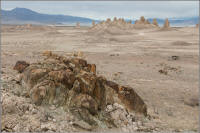 The temperatures that
night were better, only dropping into the mid thirties, but the next day
high winds at 20-30 mph and another cold front blowing in caused us to
decide it was time to leave. This time
we headed south stopping at the Ballarat ghost town in Panamint Valley and
the Trona Pinnacles further south, after passing the industrial wasteland of
the town called Trona. But the weather there was just as harsh
(cold, windy, and dusty), so we moved on, heading back over the Tehachapi's
into Bakersfield, and back up highway 99 (weather reports indicated it was snowing in Bishop).
The temperatures that
night were better, only dropping into the mid thirties, but the next day
high winds at 20-30 mph and another cold front blowing in caused us to
decide it was time to leave. This time
we headed south stopping at the Ballarat ghost town in Panamint Valley and
the Trona Pinnacles further south, after passing the industrial wasteland of
the town called Trona. But the weather there was just as harsh
(cold, windy, and dusty), so we moved on, heading back over the Tehachapi's
into Bakersfield, and back up highway 99 (weather reports indicated it was snowing in Bishop).
The DRZ400 dual sports performed well on both the 150 mile Saline Valley and 90 mile Titus Canyon loops. The only casualties of the setup was my GoPro camera and Randy's Rotopax CARB compliant tank nozzle. The tank bag that I also used (as pulled from my bigger street bike) tended to be too wide, interfering with my riding ability while standing on the pegs. The bikes themselves were flawless. The Suzukis impressed me with their dependability, agility and handling even with this extra load. They really seemed to prove their mettle, and I believe the configuration we choose did really well for this type of ride and the terrain that we covered. I am sure a bigger adventure bike would have been nice for much of the terrain and better handled the load we were carrying, but in some of the loose and rocky stuff, I think the DRZ400s were a better fit. With the appropriate air-box mod, carb re-jetting, improved exhaust, and perhaps a desert fuel tank, the DRZ400S will be more ideally ready for the next big adventure. I can hardly wait...
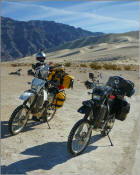 |
 |
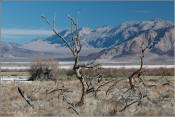 |
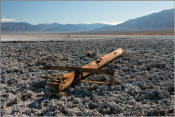 |
 |
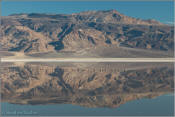 |
 |
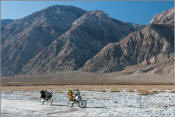 |
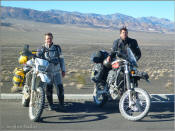 |
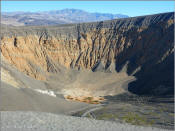 |
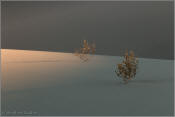 |
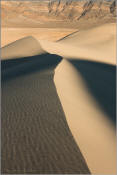 |
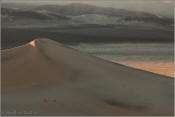 |
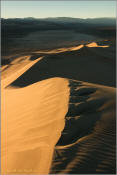 |
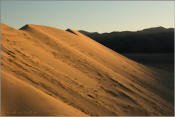 |
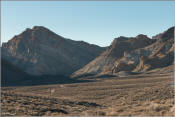 |
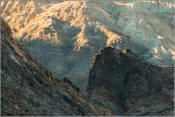 |
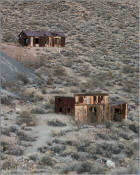 |
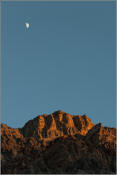 |
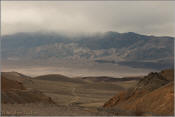 |
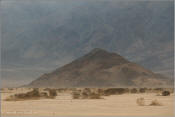 |
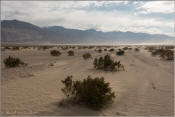 |
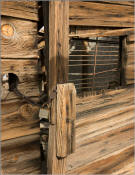 |
 |
 |
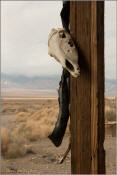 |
 |
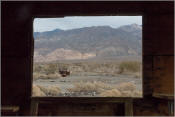 |
 |
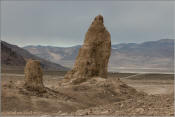 |
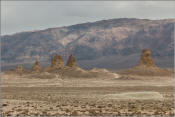 |
 |